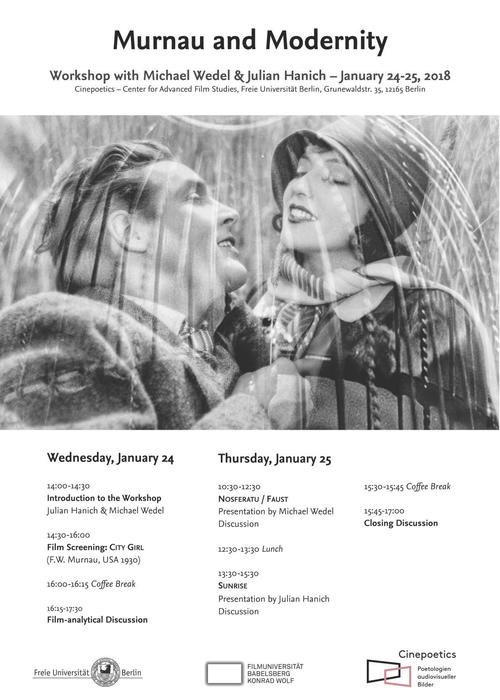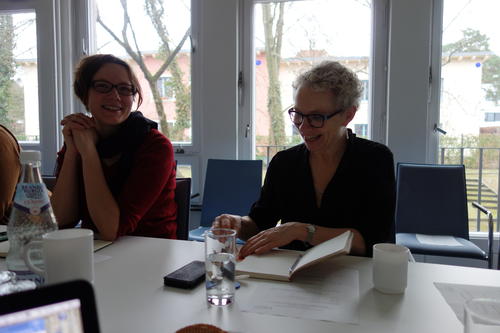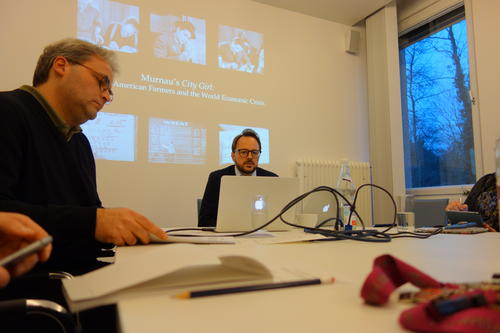Murnau and Modernity
24./25.01.2018 | Workshop by the Cinepoetics group with Michael Wedel and Julian Hanich.
Within the context of this two-day workshop, Cinepoetics co-director Michael Wedel and Julian Hanich (Rijksuniversiteit Groningen, fellow at Cinepoetics) presented their book project on film director F.W. Murnau and his role and work against the background of modernity. As Wedel and Hanich explained in their introduction, their project (which is going to be finished later this year) aims at utilizing the history and theory of modernity (as developed by thinkers such as Berman, Huyssen, Jameson, and Osborne) as a heuristic framework for a new understanding of Murnau's cinema. On the one hand, this means to engage with historically and culturally specific multiple modernities; on the other hand, it calls for considering the idea of a "singular modernity" (Jameson) which entails the interconnectedness and inherent contradictions of philosophical, socio-economic and aesthetic developments. However, drawing on Murnau himself, who once said that "the paramount task is to capture on film our time with its hopes and longings," the main focus would be on a conception of modernism as the aesthetic production of new forms of subjectivity.
Being informed by New Historicism and Cultural Poetics, the project also negotiates an understanding of culture as text (according to Greenblatt and Gallagher) and the idea of a so-called "life-world" as network of signs. Within this framework, Wedel and Hanich ask for the historicity of the poetics of cinema with the example of Murnau. More specifically, they seek to investigate his films as oscillating between realism and fantasy: this refers to his reworking of aesthetic traditions, his ways of reconfiguring generic modalities (melodrama, Kammerspiel, fantasy, comedy) and their respective affective regimes.
The workshop group then proceeded to a joint screening of Murnau's CITY GIRL (1930) and a film-analytical discussion afterwards. Also based on an unpublished text by Julian Hanich on the film, the participants discussed in what ways important historical events can change the hermeneutic horizon with regard to a cinematic object of study: CITY GIRL can be viewed as an audiovisual document of the threatening situation to American farmers at the time—referring to specific fears before the economic crash of 1929, and to more general social fears after the crash. An important cinematic motif in this regard were images of hands that could be interpreted as (symbolic) indicators of capitalism, agency, violence, or bravery. Moreover, the film deployed a sense of duration as an aesthetic value, when duration per se was also becoming a real value in modernity.
On the second day, Michael Wedel gave a presentation on two films by Murnau, NOSFERATU (1922) and FAUST (1926), discussing Murnau's cinematic concept in relation to Benjamin and Balázs, and identifying Kammerspiel and fantasy as dominant genres in the director's work. Interestingly, Murnau himself once claimed that what we conceive of as dimension of reality would not make any sense without the fantastic; thus, the interplay of both generic modes can in fact be grasped in his cinematic staging, for instance as a gesture of interlocking virtual spaces, a connection between interior and exterior settings through montage, or in the form of shadows that reach into spaces and bodies. In this regard, Eric Rohmer has also written on Murnau's spaces saying that their virtuality reaches its quality of beauty by means of movement. Even more so, according to Rohmer, Murnau would paint emotional movements through the interplay of forms and colors, achieving a certain unity of space and character. Consequently, female characters (and especially the "woman in white") often form the center of affective powers in his films, which not only describes a melodramatic mode but also how gender relations and hierarchies are negotiated in Murnau's work. What can also be observed in both NOSFERATU and FAUST is Murnau's general engagement with literature, fine arts and architecture as cultural and aesthetic discourse. Not only are these films literary adaptations, but they also perform a transformation of iconographies, for instance by means of notational iconicity.
The workshop concluded with an in-depth discussion of SUNRISE (1927) led by Julian Hanich. It focused on certain longings and fears expressed by the film that are linked to modernity: Since the film's full title is SUNRISE: A SONG OF TWO HUMANS, one of its most striking features is indeed its visual evocation of sound while being a silent movie. This also situates the film within a crucial transition period of cinema technology and modernist aesthetics.



